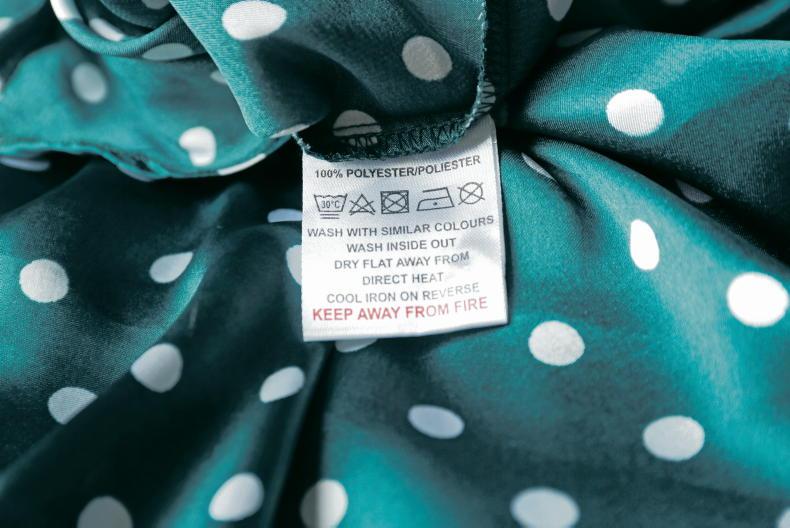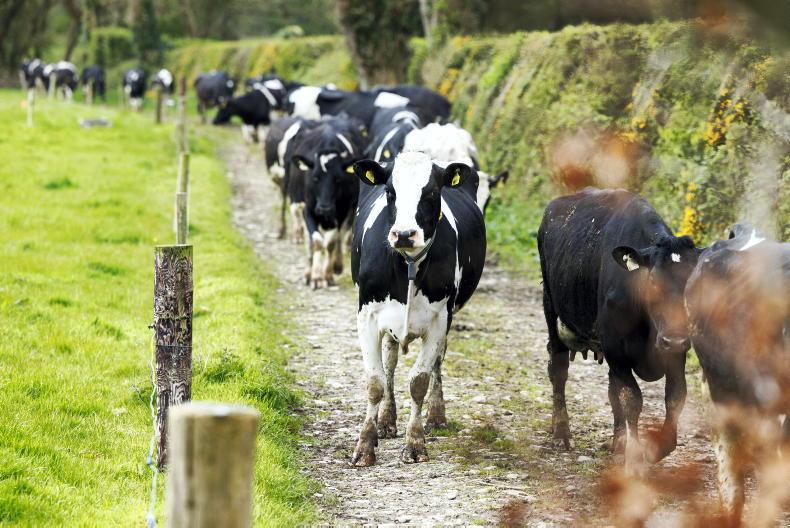I only started to take notice of how much plastic I have in my wardrobe, disguised as clothes, and I owe my rude awakening to following Éoin Dillon on Instagram. His daily stories on plastic use in the clothing industry show the impact on the environment, damage to our health and the level of greenwashing happening to keep us going back to buy more.
Keeping in mind scary statistics such as 60% of clothes are made with plastic-based materials, and 100 billion items of clothing are produced every year, it is no wonder that the global fashion industry is being put under severe pressure by governments and organisations worldwide to change the very fabric on which it is made (pun intended).
“The EU are starting to bring in regulations around the use of plastic because there have been such detrimental effects from using plastic,” explains Éoin, who has been working in the international fashion industry for over 20 years, from manufacturing to design, seeing the full cycle of brands.
“The fashion industry hasn’t actually been regulated properly yet. [Especially] when you compare it to the food industry, which has been heavily regulated for years. We forget our skin is our largest organ. As we wear plastic and we heat up, we actually absorb any petrochemical as we would any moisturiser. Petrochemicals are endocrine disruptors – man-made chemicals that may mimic or interfere with the body’s hormones, known as the endocrine system.”
Plastic levy
Considering there has been a plastic bag levy in place in Ireland since 2002 and EU regulations against the use of single-use plastics have been actioned since 2021, it begs the question: why has the clothing industry remained unregulated for so long?
“I think fashion marketing is definitely the most powerful marketing there is,” remarks Éoin. “It’s visual and an aesthetic. It taps into people’s insecurities and the need to be validated. It’s a much more psychological industry than, say, food. You can see the effects of eating bad food, but you can’t necessarily see what’s happening when you put on a suit that’s made of nylon. Plus, with the power of social media and people being validated on it has aided the growth of fast fashion.
“However, I think awareness of the fashion’s supply chain is finally being called into question,” he continues. “Plastic is made from crude oil, which is recovered from the earth using fracking. Fracking causes massive environmental damage and lots of other issues. But that supply chain from manufacturing the plastic to getting it on shelves in retail shops exists and is used widely because it is such a feasible, cheap product.”
The good versus the bad
It appears that fashion brands are highly aware of the detrimental effects of plastic, and ‘fast fashion’ has become a negative buzzword that is being offset with the marketing of new, better materials – but how can we see past the greenwashing?
“I would debate that people don’t even know what a good product feels like at this point. There’s now this ‘eco viscose’ that is being pushed, but it’s all greenwashing,” Éoin explains. “It mirrors silk, acts like silk, but it doesn’t feel exactly like silk. It’s made from polymers, which are synthetic. When you compare that to a natural fibre, like linen or wool – these are both biomaterials. They’re breathable, they’re biodegradable, they work with your skin so you don’t overheat. They’re part of our environment. If you’re wearing viscose, it’s the opposite.
“Another greenwashing term or problem is plastic blends,” he explains. “You might see a label that is 50% nylon, or 50% polyester and 50% cotton. That’s a blend. They are basically using the word ‘polycotton’ to try to greenwash. The problem is there are two different processes of recycling those materials and if they are blended together, they cannot be recycled, so it essentially becomes a single-use plastic.”
Éoin concludes: “A good rule of thumb for understanding clothing labels is how you think about food labelling… if there are too many ingredients, it’s not [a good sign].”
How to clean clothes?
“Plastic attracts oil and natural materials repel oil,” Éoin says. “So, firstly, if you do have natural materials such as cotton, wool, leather, or denim – denim is cotton as well – you don’t need to wash them as often. Not washing them after a single use is really important as you’re reducing your washing by 50%. That’s doing yourself and the environment a massive favour. Also, I believe that most new washing machines are going to come with built-in micro fibre catchers, or filters. But you can also buy filters yourself.”
How to dispose of clothes?
“Reuse and repurpose as much as you can,” he says. “They are the best two keywords. I think recycling is just another industry that’s problematic and best avoided where possible. The statistics at the moment are proving that less than 1% of clothes that are collected for recycling are actually recycled. And we touched on why that is earlier because you can’t actually recycle things that are blended.
“That’s why reusing and repurposing is so important. Keep clothes out of landfill. Donate to charity shops. Penneys now has a repairing service, which is a brilliant idea. If you pick up something in a charity shop that you love but doesn’t fit, have it altered to fit,” he recommends. “Repurpose it for your own use. Upcycle your clothes, if you can use a sewing machine. You are not only upcycling something but you are personalising it too. We’re living in an era of non-personalisation – to be able to do that is really important.”
To learn more, follow Éoin on Instagram: @reubenavenue
Read more
Have you considered hiring a dress in Ireland?
Giving pre-loved wedding dresses a second chance to shine
I only started to take notice of how much plastic I have in my wardrobe, disguised as clothes, and I owe my rude awakening to following Éoin Dillon on Instagram. His daily stories on plastic use in the clothing industry show the impact on the environment, damage to our health and the level of greenwashing happening to keep us going back to buy more.
Keeping in mind scary statistics such as 60% of clothes are made with plastic-based materials, and 100 billion items of clothing are produced every year, it is no wonder that the global fashion industry is being put under severe pressure by governments and organisations worldwide to change the very fabric on which it is made (pun intended).
“The EU are starting to bring in regulations around the use of plastic because there have been such detrimental effects from using plastic,” explains Éoin, who has been working in the international fashion industry for over 20 years, from manufacturing to design, seeing the full cycle of brands.
“The fashion industry hasn’t actually been regulated properly yet. [Especially] when you compare it to the food industry, which has been heavily regulated for years. We forget our skin is our largest organ. As we wear plastic and we heat up, we actually absorb any petrochemical as we would any moisturiser. Petrochemicals are endocrine disruptors – man-made chemicals that may mimic or interfere with the body’s hormones, known as the endocrine system.”
Plastic levy
Considering there has been a plastic bag levy in place in Ireland since 2002 and EU regulations against the use of single-use plastics have been actioned since 2021, it begs the question: why has the clothing industry remained unregulated for so long?
“I think fashion marketing is definitely the most powerful marketing there is,” remarks Éoin. “It’s visual and an aesthetic. It taps into people’s insecurities and the need to be validated. It’s a much more psychological industry than, say, food. You can see the effects of eating bad food, but you can’t necessarily see what’s happening when you put on a suit that’s made of nylon. Plus, with the power of social media and people being validated on it has aided the growth of fast fashion.
“However, I think awareness of the fashion’s supply chain is finally being called into question,” he continues. “Plastic is made from crude oil, which is recovered from the earth using fracking. Fracking causes massive environmental damage and lots of other issues. But that supply chain from manufacturing the plastic to getting it on shelves in retail shops exists and is used widely because it is such a feasible, cheap product.”
The good versus the bad
It appears that fashion brands are highly aware of the detrimental effects of plastic, and ‘fast fashion’ has become a negative buzzword that is being offset with the marketing of new, better materials – but how can we see past the greenwashing?
“I would debate that people don’t even know what a good product feels like at this point. There’s now this ‘eco viscose’ that is being pushed, but it’s all greenwashing,” Éoin explains. “It mirrors silk, acts like silk, but it doesn’t feel exactly like silk. It’s made from polymers, which are synthetic. When you compare that to a natural fibre, like linen or wool – these are both biomaterials. They’re breathable, they’re biodegradable, they work with your skin so you don’t overheat. They’re part of our environment. If you’re wearing viscose, it’s the opposite.
“Another greenwashing term or problem is plastic blends,” he explains. “You might see a label that is 50% nylon, or 50% polyester and 50% cotton. That’s a blend. They are basically using the word ‘polycotton’ to try to greenwash. The problem is there are two different processes of recycling those materials and if they are blended together, they cannot be recycled, so it essentially becomes a single-use plastic.”
Éoin concludes: “A good rule of thumb for understanding clothing labels is how you think about food labelling… if there are too many ingredients, it’s not [a good sign].”
How to clean clothes?
“Plastic attracts oil and natural materials repel oil,” Éoin says. “So, firstly, if you do have natural materials such as cotton, wool, leather, or denim – denim is cotton as well – you don’t need to wash them as often. Not washing them after a single use is really important as you’re reducing your washing by 50%. That’s doing yourself and the environment a massive favour. Also, I believe that most new washing machines are going to come with built-in micro fibre catchers, or filters. But you can also buy filters yourself.”
How to dispose of clothes?
“Reuse and repurpose as much as you can,” he says. “They are the best two keywords. I think recycling is just another industry that’s problematic and best avoided where possible. The statistics at the moment are proving that less than 1% of clothes that are collected for recycling are actually recycled. And we touched on why that is earlier because you can’t actually recycle things that are blended.
“That’s why reusing and repurposing is so important. Keep clothes out of landfill. Donate to charity shops. Penneys now has a repairing service, which is a brilliant idea. If you pick up something in a charity shop that you love but doesn’t fit, have it altered to fit,” he recommends. “Repurpose it for your own use. Upcycle your clothes, if you can use a sewing machine. You are not only upcycling something but you are personalising it too. We’re living in an era of non-personalisation – to be able to do that is really important.”
To learn more, follow Éoin on Instagram: @reubenavenue
Read more
Have you considered hiring a dress in Ireland?
Giving pre-loved wedding dresses a second chance to shine









SHARING OPTIONS